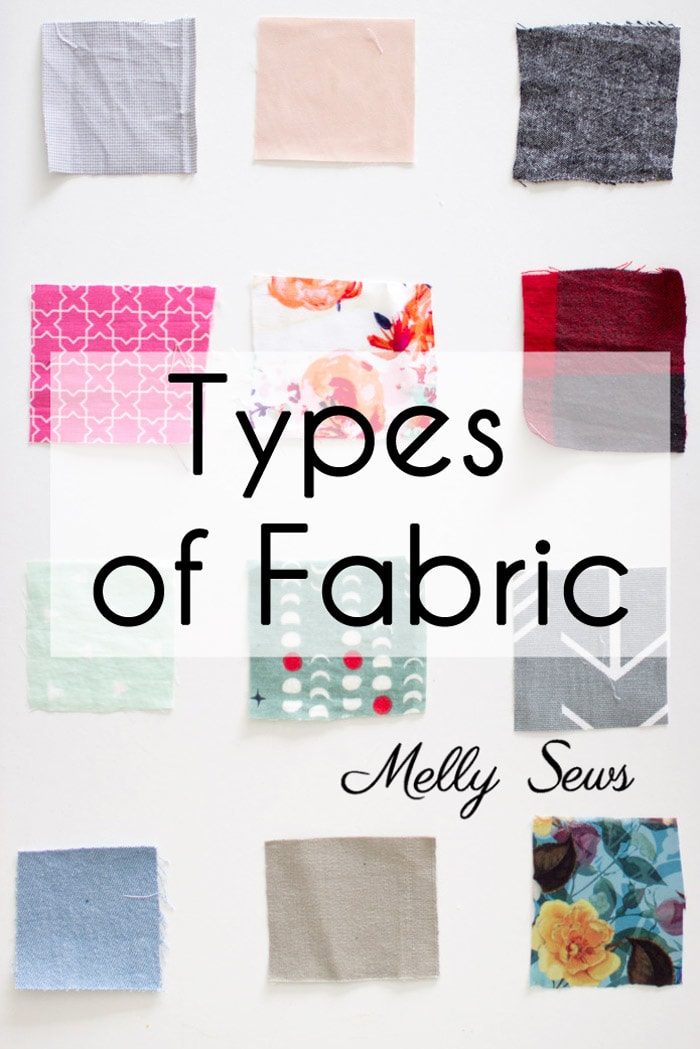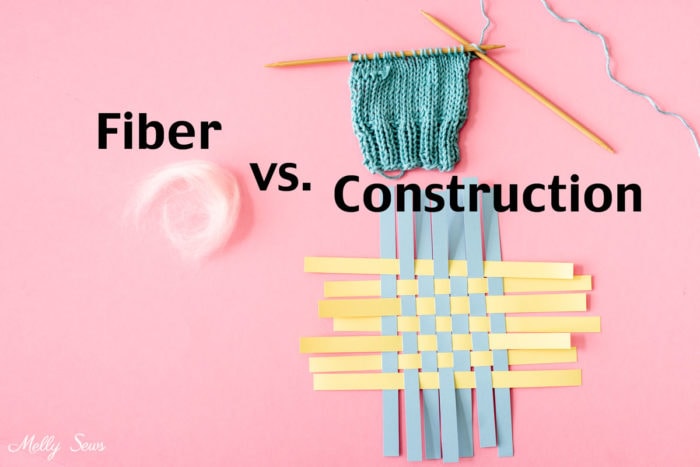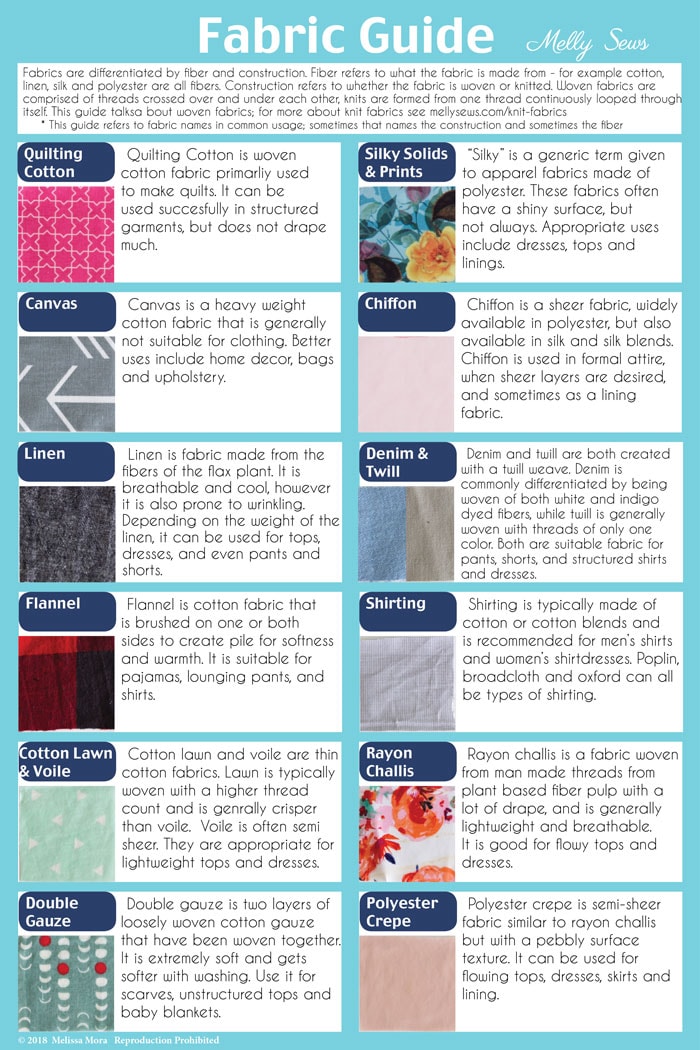Which fabric should you use for your sewing project? Learn about different kinds of fabrics.

Hey y’all, this month around here is going to be all about the basics – like fabric types. While I know many of you regular readers have a good grasp on those basics already, I hope you still learn a thing or two from these posts. Today we’re going to cover different types of fabrics – specifically woven fabrics. I realized I have a post all about knit fabrics, but that I never wrote the woven fabrics companion, so here it is. Hopefully this helps you choose the right fabric for your project.
Fiber and Construction
As a reminder, both fiber and method of construction combine to create a textile. So saying something is “cotton fabric” doesn’t actually give enough information. It doesn’t tell you if that cotton fiber is knitted or woven. Natural fibers are things like cotton, wool, linen, etc. Synthetic fibers are things like nylon, spandex, elastane, polyester, etc. These fibers are spun into thread or yarn.
Methods of construction are weaving or knitting those threads. Woven fabrics are created by crossing warp threads and weft threads over and under each other on a loom. Knitted fabrics are created by pulling loops of one thread through itself.
Different types of weaves like crepe, jacquard, brocade, twill, velvet, etc. refer to how the warp and weft threads combine. Sometimes these combinations can create a texture or pile as well. Fabrics can also be a blend of natural and man-made fiber.

Describing both the fiber and the method of construction is the most accurate way to identify fabric. For example, you might have a polyester (fiber) satin weave (woven method of construction). Acrylic (fiber) might be knitted in a cable stitch (method of construction) to create a cable sweater knit. Wool (fiber) could be woven into crepe fabric (method of construction). You get the idea.
What about leather and vinyl?
Leather is a natural material, as it grows on animals in nature. However method of construction isn’t usually described. Type of animal (cow, sheep, goat, etc), tanning process, and where the material comes from (suede is generally the underside of a hide, not the top, for example) is described instead. To read more about sewing with leather, check this post. Vinyl is an extruded plastic, not woven or knitted. Faux leather is created in a similar way, though it is generally bonded to a fabric base. For tips on handling vinyls and faux leather, see this post.
Common Woven Fabrics
This post contains affiliate links. As an Amazon Associate I earn from qualifying purchases. All affiliate links are identified with (affiliate link) after the link or a commissions earned statement above the link(s).
It wouldn’t be possible for me to cover everything about every type of fabric, so I’m going to cover commonly found woven garment fabrics and show you some examples of clothes I’ve sewn in those fabrics. For further study on fabric types, including questions on cutting, needles, and care, I recommend Fabrics A-Z (affiliate link). That book also covers upholstery fabrics for things like curtains and other home decor, while this post is focused on woven fabrics for clothing.
For stretch garments like t-shirts, see my post on knit fabrics.
To see how these fabrics move and look sewn into garments, watch the video below. If it won’t load for some reason or you prefer YouTube, you can also watch it here.
Common types of fabric found in the fabric store:
- Quilting Cotton – a medium weight type of plain weave fabric, printed, an easy fabric for sewing beginners
- Canvas a woven fabric known for durability
- Linen made from flax, breathable
- Flannel – with at least one napped (fuzzy) side, a warm fabric
- Cotton Lawn vs Cotton Voile lightweight fabric, can be sheer
- Double Gauze a fabric known for wrinkles due to different weight warp and weft threads,sheer
- Silky Solids and Polyester Prints synthetic fabrics used for garments and are generally wrinkle resistant.
- Chiffon fabric is sheer and can be made of natural fibers (silk) or synthetic (polyester). Use it for formal wear and drapes
- Denim and Twill weave are heavier weight fabrics used for things like jackets, trousers and upholstery. They are the same weave but denim is specifically a twill woven by combining white and indigo dyed threads.
- Shirting lighter weight fabric used for shirts
- Rayon Challis is a flowy fabric made from natural fibers that are synthetically processed
- Polyester Crepe a lightweight fabric often used for semi sheer blouses and dresses
Printable Fabric Guide
To summarize the properties of the fabrics I covered, I also created this fabric guide. In addition, you can click on it to download a PDF for reference.


Dara
Thank you, Melly. Very informative!
Lisa
Thank you so much for your informative and helpful website. As a beginner to sewing I love everything you have to offer from the classes about sewing to the fun and often easy tutorials.
I look forward to each project now and don’t feel quite so overwhelmed. Thank you “sew” much🙂
Teresa O
Great information for a beginner sewer like myself. Thank you 😊
Catherine MacLellan
Thanks Melly, as usual very informative and helpful to us beginners.
Dianne
Hi Melly – thanks for the informational article. Have been out of the clothes sewing scene for too long and wondered about making a summer blazer for myself. Thinking a lightweight twill or perhaps a poplin(cotton/polyblend) might be suitable?? If you have other suggestions that would be workable please feel free to suggest – I’m woefully behind on all the choices that are available.
Sophia MacDonald
Thanks for all your tips. I’ve been sewing for 65 years and still learn new things from you. Keep them coming.
Beverly
This was a great presentation. I learned so much information that I thought I already knew! Thank you. I really enjoy all of your videos.
Rebecca
Thank you! This is perfect for me now when I hit the fabric stores found my perfect pattern but what kind of material? Now I know. Thanks so much
Viv
Thank you Melly, this is so helpful and I won’t be buying fabric without considering what I will use it for.
Ima
Thanks for this Info.